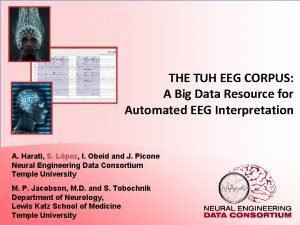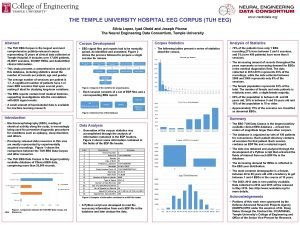THE TEMPLE UNIVERSITY HOSPITAL EEG CORPUS TUH EEG

- Slides: 1

THE TEMPLE UNIVERSITY HOSPITAL EEG CORPUS (TUH EEG) www. nedcdata. org Silvia Lopez, Iyad Obeid and Joseph Picone The Neural Engineering Data Consortium, Temple University Abstract Corpus Development Corpus Statistics Analysis of Statistics • The TUH EEG Corpus is the largest and most comprehensive publicly-released corpus representing 12 years of clinical data collected at Temple Hospital. It includes over 17, 000 patients, 25, 000+ sessions, 50, 000+ EEGs and deidentified clinical information. • EEG signal files and reports had to be manually paired, de-identified annotated. Figure 2 shows the process followed to prepare a single session for release. • The following tables present a series of statistics about the corpus. • 70% of the patients have only 1 EEG recording, 27% have between 2 and 5 sessions, and 3% (over 400 patients) have more than 5 sessions. • The increasing amount of records throughout the years represents an increasing demand for EEGs in the medical diagnostics field. The data collected in 2012 -2013 represents 35% of the recordings, while the data collected between 2000 and 2005 represents only 8% of the sessions. • This study presents a comprehensive analysis of this database, including statistics about the number of records per patient, age and gender. • The average number of sessions per patient is 1. 7. A significant number of patients have 3 or more EEG sessions that span several years, making it ideal for studying long-term variations. • The EEG reports contain brief medical histories, supporting investigations into the correlations with EEG signal events. Figure 2. Diagram of the workflow for preparing data. • Each session consists of a set of EDF files and a corresponding EEG report. • A small amount of hand-labeled data is available for machine learning research. • The female population represents 52% of the total. The number of female and male patients is relatively even, with a slight female majority. • 60% of the population is between 40 and 69 years old, 26% is between 0 and 39 years old and 15% of the population is 70 or older. • Approximately 75% of the sessions are classified as abnormal EEGs. Figure 3. Directory Tree of the Database Introduction Summary • Electroencephalography (EEG), reading of electrical activity along the scalp, is increasingly being used for preventive diagnostic procedures for conditions such as epilepsy, sleep disorders and others. • The EEG TUH Data Corpus is the largest publicly available clinical EEG database – at least two orders of magnitude larger than other corpora. • Previously released data resources in this area are mostly represented by experimentally acquired recordings. Figure 1 shows the comparison between the TUH EEG Data Corpus and other resources. • The TUH EEG Data Corpus is the largest publicly available database of Clinical EEG data, comprising more than 25, 000 records. Data Analysis • Generation of the corpus statistics was accomplished through the analysis of information contained in the EDF headers. Figure 4 shows some information contained in the fields of the EDF file header. Field Description Example 1 Version Number 0 2 Patient ID 3 Gender M 4 Date of Birth 57 8 Firstname_Lastname 11 Startdate 13 Study Number/ Tech. ID 14 Start Date 01. 05. 10 15 Start Time 11. 39. 35 16 Number of Bytes in Header 17 Type of Signal 19 Number of Data Records 20 Dur. of a Data Record (Secs) 21 No. of Signals in a Record 27 Signal[1] Prefiltering 28 Signal[1] No. Samples/Rec. 250 TUH 123456789 01 -MAY-2010 TUH 123456789/TAS X 6400 EDF+C 207 1 24 HP: 1. 000 Hz LP: 70. 0 Hz N: 60. 0 Figure 4. Examples of information contained in an EDF file header other Figure 1. Comparison between the TUH EEG Data Corpus and Resources • A Python script was developed to read the necessary information from each EDF file in the database and later analyze the data. • The database is organized by sets of 100 patients for convenience. Each patient directory contains all sessions for that patient. Each session contains an EDF file and a redacted report. • The data was obtained analyzed through the development of a Python script that extracted the fields of interest from each EDF file in the database. • The increasing demand for EEGs is reflected in the EEG year distribution. • The most common demographic is a female, between 40 to 69 years old with a tendency to get between 1 and 4 EEGs in the course of 10 years. • The 2002– 2013 data is now publicly available. Data collected in 2014 and 2015 will be released in May 2015. See http: //www. nedcdata. org for more details. Acknowledgements • Portions of this work were sponsored by the Defense Advanced Research Projects Agency (DARPA) MTO under the auspices of Dr. Doug Weber through the Contract No. D 13 AP 00065, Temple University’s College of Engineering and Office of the Senior Vice-Provost for Research.

